Rainforests ‘Worth More Alive Than Dead’
Air Date: Week of November 8, 2019
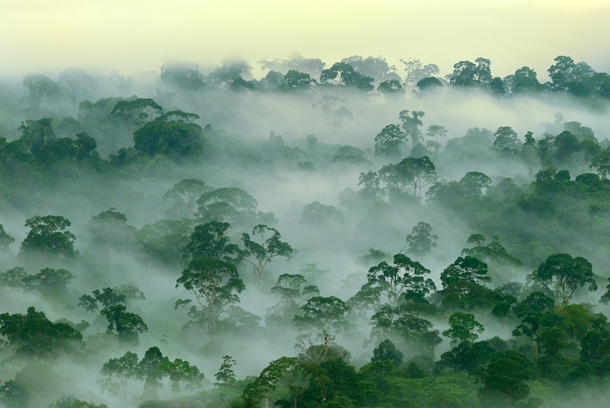
Through a mechanism called the biotic pump, rainforests are able to generate rain that falls back on them and can even influence faraway climates. (Photo: Thomas Marent)
Earth’s rainforests are astonishingly biodiverse ecosystems that can even drive the climates on faraway continents. But they’re disappearing in the name of the kind of economic development that values rainforests more when logged, mined, or turned into farmland. Tony Juniper, author of the book Rainforest: Dispatches from Earth’s Most Vital Frontlines, joins Host Steve Curwood to discuss the amazing science of how rainforests work and why leaving them intact offers more, not less, economic benefit.
Transcript
CURWOOD: It’s Living on Earth, I’m Steve Curwood.
From the Congo to the Amazon to Borneo, rainforests are home to countless species we haven’t even discovered yet. But these treasures of biodiversity are rapidly disappearing. Western market forces place a higher value on soy, oil palm, or cattle that are grown on deforested land than on the intact rainforest itself. In Brazil, for instance, slash-and-burn efforts to clear the Amazon have led to an increase in deforestation in 2019 of about 85%, compared to 2018. All is not yet lost, but we’re running out of time, writes author Tony Juniper. Tony’s new book, Rainforest: Dispatches from Earth’s Most Vital Frontlines relates the astonishing science of how Earth’s rainforests are connected with climates and landscapes all the way around our blue green marble and uses conservation success stories as a roadmap for saving what’s left. He joins me now from Cambridge, in the UK. Tony, welcome back to Living on Earth!
JUNIPER: Very nice to see you again, Steve.
CURWOOD: What's famous about the Amazon rainforest to many people is that it is incredibly diverse. A temperate forest might have maybe half a dozen or a dozen tree species, you write in your book. But of course, a tropical rainforest is gonna have, what, 500 or more in a single hectare! Why are rainforests so incredibly diverse, what makes them so?
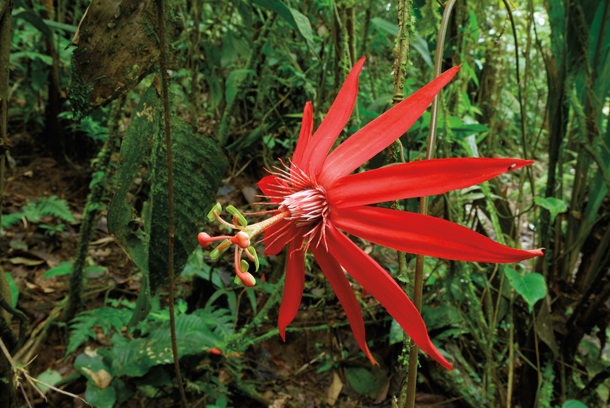
Tropical rainforests require flowering plans to invest in blooms and nectar to attract animals to move their pollen. Passion Flower (Passiflora vitifolia), Costa Rica. (Photo: Thomas Marent)
JUNIPER: This is a really good question, one that's been pored over by ecologists for decades. My answer would be it comes down to the long term stability of these systems and the extent to which they don't really have seasons. So in a temperate forest, you find we go through spring, summer, autumn, winter, and the system is being interrupted. But in the tropical forest, you have this continuity of circumstances running through the entire year, year after year. And this causes the ecology to become very diverse with lots of threads of interconnections being created, that otherwise wouldn't necessarily be sustained if you had these seasonal annual interruptions. And you can look at all these threads of connections and they become very, very specialized in tropical forests with, for example, a single insect being the sole pollinator of a particular kind of plant, a particular tree; its fruit is being moved by a particular partner bird or mammal. And those things, they become very tightly woven. And the other thing is the extent to which these conditions create opportunities for diseases as in pests to become very rapacious. And so the trees and other organisms have adapted strategies to be able to cope with attacks by pests by dispersing themselves through the forest and making sure that any one species is living at quite low density. So, it's the combination of these kinds of factors, which I think come down in the end to this very high level of productivity coupled with stability, that leads to these incredible webs of life to emerge over long periods of time.
CURWOOD: Tony, there's really interesting part of your book, Rainforest: Dispatches from Earth's Most Vital Frontlines, where you describe how the rainforests like the Amazon can drive their own weather. Talk to us about how this biotic pump works, please.
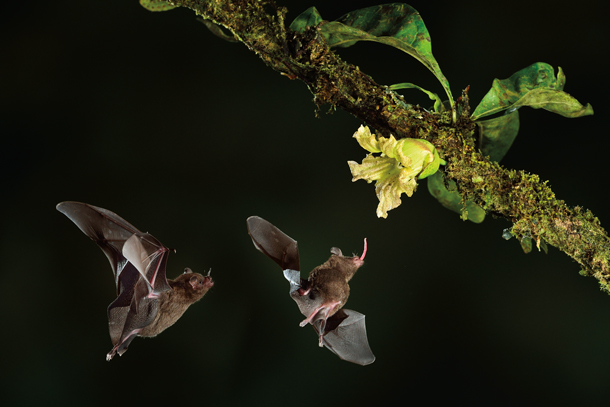
An astonishing diversity of insects, birds, and bats help pollinate the flowers of rainforest plants. Geoffroy’s tailless bat (Anoura geoffroyi), Costa Rica. (Photo: Thomas Marent)
JUNIPER: So you imagine the forest there, and rainforests, obviously, they have a lot of water falling upon them. Less appreciated is the amount of water coming out. And so across the Amazon each day, some 20 billion tons of water are being evaporated into the atmosphere. And when that water vapor is coming from the leaves on the trees, it's in the form of a gas, vapor. But when that vapor, what goes up into the air on the warm rising air currents that are being driven by the sunshine, the water vapor gets up to high altitude, and when it gets to high altitude, it condenses, it turns back into tiny water droplets because of the cooler conditions. And at that point, the vapor going from gas to liquid, it collapses in on itself, it occupies a smaller space of atmosphere. And this then creates a vacuum, which then causes this colossal, powerful updraft to come from beneath. So the condensation is really a pump that's driving the air currents skywards, and then you get these towering great storm clouds over the forest. And they're obviously creating vast amounts of rainfall, but they're also driving atmospheric circulation at a much bigger scale, with the Hadley cells, which drive the circulation of the Earth's atmosphere in the middle latitudes being driven by this updraft reaching a certain altitude, then going horizontally towards the subtropics. And as the forest is pumping air skywards, it's drawing in air from the side, you could imagine this circulation where air is coming off of the sea. And as it's being pulled off of the sea by this vacuum that's pushing the moisture up into the sky, it's bringing in moisture off of the Atlantic and then that's being pulled right across thousands of miles of the rainforest towards the great wall of the Andes Mountains. And this great system is only now really just beginning to be appreciated. But it has huge implications for the entire world because those moist forests that run around the equator, some of them at least, are pushing out water that's traveling thousands of miles. And indeed, during the course of my research, I spoke to American researchers who were finding connections between the forests of Central America and the Amazon, and indeed the grain fields of the Great Plains of North America, in the Dakotas and in Manitoba into Canada, water even traveling that far, which has its origins over the tropical rainforests.
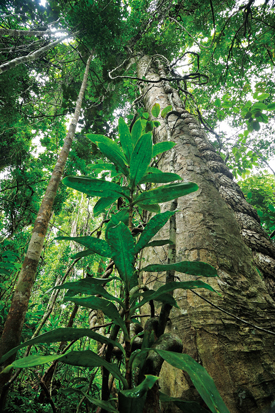
Giant trees like this one hold a high proportion of the above ground carbon trapped in the living fabric of the forest. Masoala National Park, Madagascar. (Photo: Thomas Marent)
CURWOOD: You write about how dust serves as a natural fertilizer and gets to the Amazon rainforest on the wind. How does that work?
JUNIPER: One of the things about the tropical rainforests is how they are living on a nutrient knife-edge, that the nutrients are being consumed in a voracious way because of the way the plant growth is, is so rapid and so lush. And some of those nutrients are being lost along rivers as a result of the decay of plant material. And some of that is being washed into waterways and being removed. And in those areas of tropical rain forests that are on very ancient rocks, the nutrients were used up tens of thousands of years ago. And so in order for the forest to continue to function, nutrients need to come in from elsewhere. And one connection that I write about is the input of nutrients coming from the North African Sahara Desert, and how that driest part of the world is helping the ecosystem in one of the wettest parts of the world to function. And there's a place in the Sahara called the Bodélé Depression, where great dust storms occur quite regularly. And this is kicking up material into the atmosphere that's traveling at high altitude and you can see this on satellite photographs showing this dust plume going away across the Atlantic, with some of this material falling out over the Amazon, bringing with it, for example, phosphorus, an essential plant nutrient, which is helping the system to keep going. And it's another example of these global interconnections. One is water, one is carbon, and another is nutrients. And I think you know, the more we understand about all of these things, the more we can see the interconnectedness of how this entire system is working.
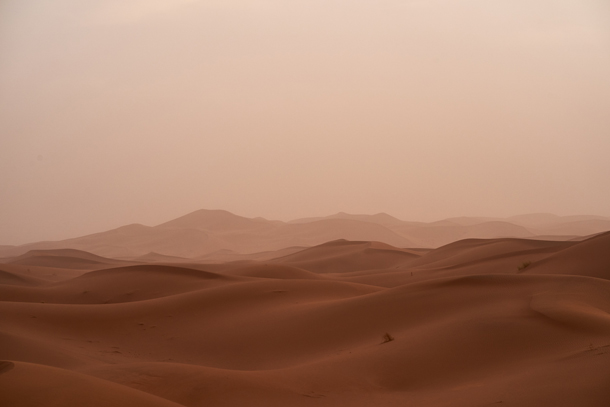
Dust from the Sahara Desert provides vital nutrients for the Amazon rainforest. (Photo: Wolfgang Hasselmann, Unsplash, public domain)
CURWOOD: Just recently, the United States and Brazil agreed to promote private sector development in the Amazon and in fact, Brazil's foreign minister said that opening the rainforest to economic development was, in his view, the only way to protect it. And they pledged 100 million dollars to a biodiversity conservation fund. How helpful do you think this is, or not?
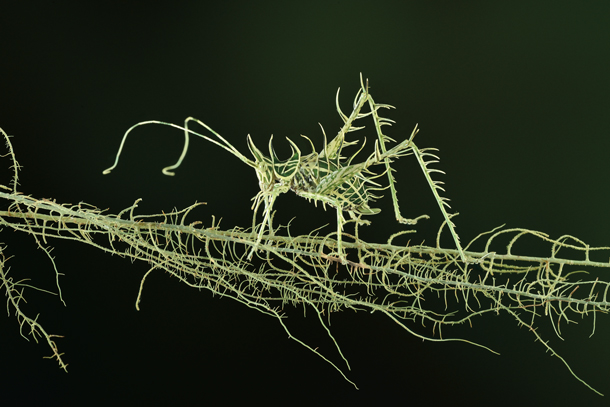
Some ecologists hypothesize that the lack of seasons and long periods of stability in rainforests have contributed to elaborate evolutionary adaptations like the camouflage on this lichen katydid (Markia hystrix) in Costa Rica. (Photo: Thomas Marent)
JUNIPER: It will depend upon the details and what kind of development the strategists of that kind of program have in mind. But what I would point out is how the rainforests are already very important for economic development for the people who've lived there for thousands of years, namely, the indigenous people. And it's really a question of what kind of economy we think can coexist with those ecosystems, because the indigenous people have been there, literally for thousands of years, and they've been sustaining their societies, their civilizations, through an economic system that regards the forest as worth more alive than dead. The Western kind of economic model tends to see the forest as most valuable when it's been converted into timber, or when the minerals have been extracted from underneath, or when the forest has been cleared away to make way for agriculture. And so economic development can mean many things to many different interest groups, and it certainly can be compatible with the long term conservation of the forest. But if the decision makers who are putting together these proposals think that economic development that involves the removal of the forest and its replacement with fields, farms, hydroelectric dams, and mines is sustainable, then I would beg to differ. I don't think that is sustainable. And in the case of the Amazon, we're approaching the point where we know that we do run the risk of reaching tipping points whereby we will have cleared so much forest, that even that which is left will no longer function properly, because the system has been degraded beyond the state that keeps it going. And this is particularly the case in relation to rainfall. And the extent to which that will remain a wet forest, after a certain level of clearance and fragmentation that causes that finely-poised hydrological system to break down in ways that cause it to turn into a savanna, or even into a grassland. And when it's in those states, that territory, it will provide a different set of values to the world than those which it's providing now. And those values that we're getting at the moment are important for the entire planet, from the point of view of economic development, literally. And so we know climate change is a global problem. And the carbon that's held in those forests at the moment is benefiting the entire world economy. If we start to degrade that function in order to get short term economic growth of the Western kind, then I do think that would be a mistake.
CURWOOD: Now, I understand that Indonesia has made attempts to curb deforestation and the associated fires there. And in June of 2019, the Environment Minister pledge to make a moratorium on new forest clearing for palm plantations or logging operations, make that permanent. How effective has that moratorium been so far?
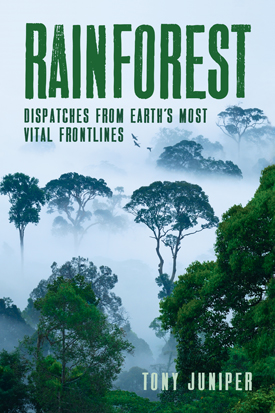
Tony Juniper is the author of Rainforest: Dispatches from Earth’s Most Vital Frontlines and eight other books. (Photo: Thomas Marent)
JUNIPER: It's to be warmly welcomed that we see this kind of policy being laid out by the Indonesian government. But as is the case everywhere it's the difference between the ambition and the practical implementation, which is really the key test. And in Indonesia, a very complex situation exists on the ground whereby government policy isn't necessarily translated into the kinds of things that we would hope to see. And there is a high level of illegal activity in that country in terms of land that should be protected inside national parks and other conservation areas being encroached by palm oil plantations or illegal logging operations. One would hope that the Indonesian government can be working with others to be able to not only set out the ambition of policy and to back that with good science, but to have the means to be able to implement that on the ground. And this is, you know, it's not only about the question of illegal versus legal activities, of course, this is about social development with very large numbers of people living in remote rural areas who often have little opportunity other than to be growing crops for either their own consumption or for market, and being able to work with them to enable and to support sustainable practices so that they can make a living without destroying the forest.
CURWOOD: There have been successes in protecting rainforests around the planet. And you write with some enthusiasm about what's happened in East Africa and Tanzania, in the mountains there, the Amani forest. Describe that for us, would you please.

Fungi are among the myriad of species that assist in the rapid recycling of nutrients in rainforests. Cup fungi, Choco rainforest, Colombia. (Photo: Thomas Marent)
JUNIPER: So there's this fragment of upland forest in the Tanzanian Highlands, an area of incredible biological richness, lots of species unique in the world there. And, you know, the forest has been highly fragmented and much of it gone. And there's one area that was considered doomed by scientists back in the 1970s, but which is still there, as a result of people taking a much more integrated approach towards local communities, being able to help people make a living out of their land without encroaching into the forest any further and on the back of that community engagement to be able to think about how to reconnect areas of the little bits of forest that remain to create bigger tracts, which would be much more resilient in the future in being able to hang on to their wildlife. And so this is really a story of social development and community engagement. And across the world, we can see many examples of this. And another one, which I wrote about in the book, which is, I find quite inspiring, at least, is the example of Costa Rica, which sought a route towards economic development that not only didn't involve deforestation, but included putting much of the forest back. And if you look at that country, between the 1980s and now the forest cover has doubled, so has the country's per capita GDP. And this was through the realization, literally, by the finance ministry in that country 30 years ago, that the forest was worth more for the nation alive than dead. And they have good reasons to think that in terms of their power sector, their electricity was coming from hydroelectric dams that were being powered by rivers topped up by rain forests. They found that they had vast quantities of clean water coming out of the forest that didn't need to be cleaned up in water treatment works. And then the real visionary opportunity that they spotted was for eco tourism. And so putting all these things together, and in the future, they may be able to participate in carbon markets too, they've managed to hang on to the forest, expand it, at the same time as grow their agricultural sector. They are a very major exporter of coffee, of pineapples and bananas. And they've blended all of these economic dimensions into a plan which is really about keeping the forest there for the national good. So if you want to have development into the future, keep and expand the forest. That's what the science and indeed the good practice is now telling us.
CURWOOD: Tony Juniper is Chair of Natural England and author of Rainforest: Dispatches from Earth's Most Vital Frontlines. Tony, thanks so much for taking the time with us today.
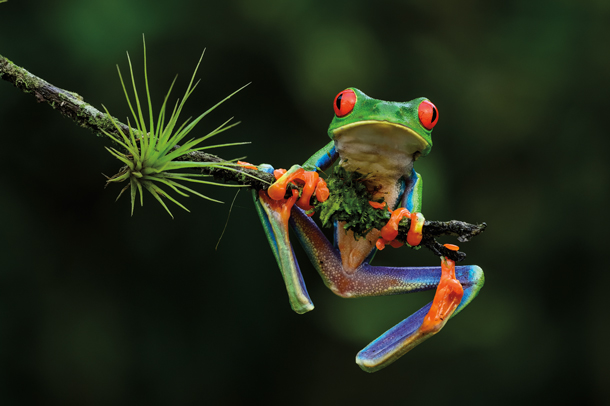
Costa Rica is home to over 174 species of toads, salamanders, and frogs like the red-eyed tree frog (Agalychnis callidryas). (Photo: Thomas Marent)
JUNIPER: My pleasure, Steve, it was a great joy to be able to sit and speak for a bit.
Links
Rainforest: Dispatches from Earth’s Most Vital Frontlines by Tony Juniper
Listen to LOE’s segment discussing the Pope’s Amazon Synod
Listen to LOE’s segment on how healthcare and forest health can go hand in hand
Living on Earth wants to hear from you!
Living on Earth
62 Calef Highway, Suite 212
Lee, NH 03861
Telephone: 617-287-4121
E-mail: comments@loe.org
Newsletter [Click here]
Donate to Living on Earth!
Living on Earth is an independent media program and relies entirely on contributions from listeners and institutions supporting public service. Please donate now to preserve an independent environmental voice.
NewsletterLiving on Earth offers a weekly delivery of the show's rundown to your mailbox. Sign up for our newsletter today!
 Sailors For The Sea: Be the change you want to sea.
Sailors For The Sea: Be the change you want to sea.
 The Grantham Foundation for the Protection of the Environment: Committed to protecting and improving the health of the global environment.
The Grantham Foundation for the Protection of the Environment: Committed to protecting and improving the health of the global environment.
 Contribute to Living on Earth and receive, as our gift to you, an archival print of one of Mark Seth Lender's extraordinary wildlife photographs. Follow the link to see Mark's current collection of photographs.
Contribute to Living on Earth and receive, as our gift to you, an archival print of one of Mark Seth Lender's extraordinary wildlife photographs. Follow the link to see Mark's current collection of photographs.
 Buy a signed copy of Mark Seth Lender's book Smeagull the Seagull & support Living on Earth
Buy a signed copy of Mark Seth Lender's book Smeagull the Seagull & support Living on Earth

